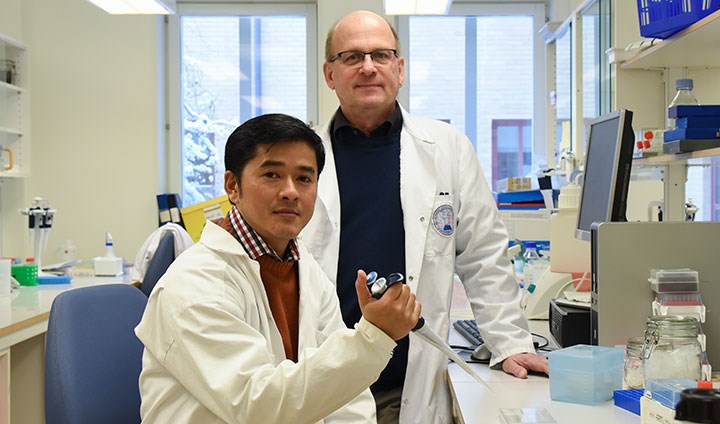Fewer and poorer quality sperm

Ajay Pradhan and Per-Erik Olsson
In research on zebrafish, Örebro researchers have identified a gene that is essential for producing sperm. Results show that fewer and poorer quality sperm are produced when the gene was turned off with the Crispr/Cas9 technique. The next step is to test whether the same is true in humans.
CRISPR/Cas9 is cheaper, easier and faster to use in making specific changes in the genome than previous methods. It can be used to create a mutation at a particular site in the genome so that the production of protein from a particular gene is turned off. As the researchers did in zebrafish.
Why zebrafish? Seventy per cent of the human genes have a clear counterpart in the zebrafish genome, and the development of the fish is very similar to that of humans but much faster. By turning on or off individual genes in a fish embryo, researchers can see what is changing – and then test whether that knowledge can be applied to humans.
The Örebro researchers belong to The Life Science Centre
“The same gene is found in humans, and it is possible that it affects people in the same way. If the gene is altered in men, they may not be able to have children,” says Per-Erik Olsson, professor of biology at Örebro University.
The research is a collaboration with researchers in Singapore at the Temasek Life Sciences Laboratory. Both research teams investigate what determines whether we become male or female and have worked together for over eight years.
“They contacted us for a collaboration to find out more about this particular gene – HSF5 – and what it does,” says Per-Erik Olsson, who has conducted the study together with Ajay Pradhan, a biology researcher at Örebro University.
With the help of the new technology, Crispr/Cas9, the researchers were able to solve the riddle. With this new technology, they could turn off the HSF5 gene in zebrafish to see what happens when the gene could not execute its task.
“The result is fewer sperms and the ones produced are not viable. Their heads are far too big, and they have small, short tails. They simply cannot swim,” says Ajay Pradhan.
On the other hand, the gene does not seem to have any effect on women – researchers saw no difference when the gene was blocked in female zebrafish.
“Now we know that the protein created from the HSF5 gene is important for sperm development. The next step for us is to find out what determines how much protein is produced,” explains Ajay Pradhan.
“It may be that certain chemicals affect this gene, thus leading to infertility. Many have difficulties in getting pregnant today, and we do not know why so more research is needed,” says Per-Erik Olsson.
Text and photo: Linda Harradine
Translation: Jerry Gray
